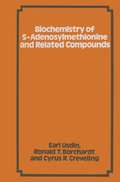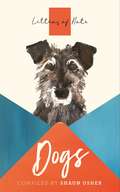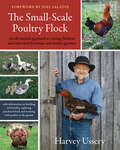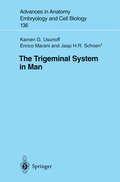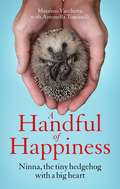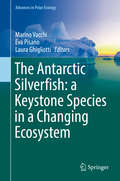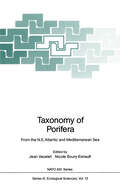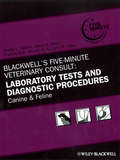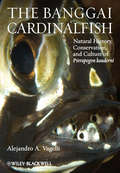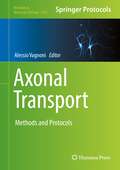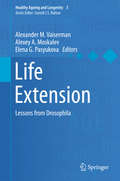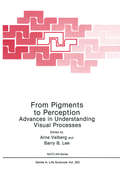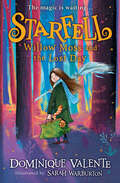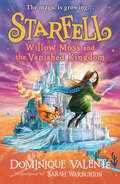- Table View
- List View
Letters of Note: Dogs
by Shaun UsherIn Letters of Note: Dogs, Shaun Usher brings together a delightful collection of correspondence about our canine friends, featuring affectionate accounts of pups’ playful misdemeanours, heartfelt tributes to loyal fidos and shared tales of remarkable hounds. Includes letters by: Clara Bow, Bob Hope, Charles Lamb, Sue Perkins, Marcel Proust, Gertrude Stein, E.B. White & many more
The Small-Scale Poultry Flock: An All-Natural Approach to Raising Chickens and Other Fowl for Home and Market Growers
by Harvey Ussery Joel SalatinThe most comprehensive guide to date on raising all-natural poultry for the small-scale farmer, homesteader, and professional grower. The Small-Scale Poultry Flock offers a practical and integrative model for working with chickens and other domestic fowl, based entirely on natural systems. Readers will find information on growing (and sourcing) feed on a small scale, brooding (and breeding) at home, and using poultry as insect and weed managers in the garden and orchard. Ussery's model presents an entirely sustainable system that can be adapted and utilized in a variety of scales, and will prove invaluable for beginner homesteaders, growers looking to incorporate poultry into their farm, or poultry farmers seeking to close their loop. Ussery offers extensive information on: The definition of an integrated poultry flock (imitation of natural systems, integrating patterns, and closing the circle) Everything you need to know about your basic chicken (including distinctive points about anatomy and behavior that are critical to management) Extended information on poultry health and holistic health care, with a focus on prevention Planning your flock (flock size, choosing breeds, fowl useful for egg vs. meat production, sourcing stock) How to breed and brood the flock (including breeding for genetic conservation), including the most complete guide to working with broody hens available anywhere Making and mixing your own feed (with tips on equipment, storage, basic ingredients, technique, grinding and mixing) Providing more of the flock's feed from sources grown or self-foraged on the homestead or farm, including production of live protein feeds using earthworms and soldier grubs Using poultry to increase soil fertility, control crop damaging insects, and to make compost-including systems for pasturing and for tillage of cover crops and weeds Recipes for great egg and poultry dishes (including Ussery's famous chicken stock!) And one of the best step-by-step poultry butchering guides available, complete with extensive illustrative photos. No other book on raising poultry takes an entirely whole-systems approach, or discusses producing homegrown feed and breeding in such detail. This is a truly invaluable guide that will lead farmers and homesteaders into a new world of self-reliance and enjoyment.
The Trigeminal System in Man (Advances in Anatomy, Embryology and Cell Biology #136)
by Kamen G. Usunoff Enrico Marani Jaap H.R. SchoenThis monograph offers a comprehensive review of present knowledge of the structure and connections of the trigeminal nuclei in humans, and compares it to laboratory animal findings. The authors provide cytoarchitectural data from their own research, and trace trigeminal pathways in human material by means of the Nauta technique. In humans the trigeminal nuclear complex includes the motor nucleus, the principal sensory (pontine) nucleus, the spinal nucleus (subdivided into oral, interpolar and caudal nuclei), and the mesencephalic nucleus and several small nuclei. The supratrigeminal nucleus, as described in various mammals, is not defined in the human brain. The primary afferents to all subdivisions of the trigeminal nuclear complex in humans appear to be entirely ipsilateral. Some of the 'extratrigeminal' primary afferents described in experimental animals are also present in the human brain and the nucleus ovalis receives primary and possibly secondary afferents from the trigeminal systems. A significant difference between the human trigeminal system and the subprimate species is seen in the monosynaptic cortical projection to the motor trigeminal nucleus.
Clostridial Diseases of Animals
by Francisco A. Uzal J. Glenn Songer John F. Prescott Michel R. PopoffClostridial Diseases of Animals is the first book to focus on clostridial diseases in domestic and wild animals, offering a comprehensive reference on these common diseases. Provides a single resource for all aspects of clostridial diseases Presents current, comprehensive information with a focus on clinical relevance Covers each disease in depth, including etiology, epidemiology, clinics, gross pathology, histopathology, diagnostics, diagnostic criteria, prophylaxis, control, and treatment Written by the world-leading experts in the field of clostridial diseases in animals Offers photographs and summary tables to support the concepts discussed in the text and aid in recognition
Clostridial Diseases of Animals
by Francisco A. Uzal J. Glenn Songer John F. Prescott Michel R. PopoffClostridial Diseases of Animals is the first book to focus on clostridial diseases in domestic and wild animals, offering a comprehensive reference on these common diseases. Provides a single resource for all aspects of clostridial diseases Presents current, comprehensive information with a focus on clinical relevance Covers each disease in depth, including etiology, epidemiology, clinics, gross pathology, histopathology, diagnostics, diagnostic criteria, prophylaxis, control, and treatment Written by the world-leading experts in the field of clostridial diseases in animals Offers photographs and summary tables to support the concepts discussed in the text and aid in recognition
The Segmentation of the Primitive Neural Tube in Chick Embryos: A Morphological, Histochemical and Autoradiographical Investigation (Advances in Anatomy, Embryology and Cell Biology #41/3)
by Sigmund VaageA Handful of Happiness: Ninna, the tiny hedgehog with a big heart
by Massimo VacchettaThe heart-warming story of how a tiny hedgehog helped one man find hope. 'Could you look after it for a couple of days? . . .' So begins the extraordinary friendship between veterinarian Massimo, who is at a low spot in his life, and a tiny, orphaned hedgehog. Only a few days old, covered with soft, white quills and mewling quietly, this little creature will turn around his life forever. Through the sheer force of Ninna's personality - curious, playful, affectionate - and the sudden, unexpected paternal protectiveness he feels nursing her back to health, Massimo reconnects with the world - and finally begins to feel like home. But as Ninna wakes from her first hibernation, she grows up, like any teenager, longing for freedom. A creature of the wild, she craves the free range of the woods beyond Massimo's house. Massimo must accept that Ninna is ready to move on . . . but one little hedgehog saved and released into her natural habitat is a new beginning for Massimo: setting up a sanctuary for the injured, orphaned, fragile - but with a will to live so strong it is truly contagious.A Handful of Happiness is their funny and life-affirming story - a celebration of our favourite prickly wildlife creature, which will make you laugh and cry. Perfect for animal lovers and fans of A Streetcat Named Bob, Arthur, Finding Gobi and Monty Don's Nigel.
The Antarctic Silverfish: a Keystone Species in a Changing Ecosystem (Advances in Polar Ecology #3)
by Marino Vacchi Eva Pisano Laura GhigliottiThis book encompasses the body of available scientific information on the notothenioid fish Pleuragramma antarctica commonly known as Antarctic silverfish. This plankton-feeder of the intermediate trophic level is the most abundant fish in the coastal regions of high Antarctica, and plays a pivotal ecological role as the main prey of top predators like seals, penguins, whales and Antarctic toothfish. Broad circum-polar distribution, a key role in the Antarctic shelf pelagic ecosystem, and adaptations makes understanding the species’ likely response to environmental change relevant to foresee the potential responses at the local ecosystem level. Additionally, a detailed understanding of the abundance and trophic interactions of such a dominant keystone species is a vital element of informing the development of marine spatial planning and marine protected areas in the Antarctic continental shelf region.Experts in the field provide here unique insights into the evolutionary adaptation, eco-physiology, trophic ecology, reproductive and population ecology of the Antarctic silverfish and provide new clues about its vulnerability in facing the challenges of the ongoing environmental changes.
Taxonomy of Porifera: From the N.E. Atlantic and Mediterranean Sea (Nato ASI Subseries G: #13)
by Jean Vacelet Nicole Boury-EsnaultAlthough sponges are one of the major components of littoral ecosystems, their systematics obviously lags behind that of the majority of other groups of marine invertebrates. Also the evolutionary trends in these most primitive of the Metazoans are poorly understood. The confused state of their taxonomy and the difficulties with their identification prevent their use in ecological studies. The emphasis of interest presently seems to have shifted towards chemistry, but many of the hundreds of interesting chemicals recently described in sponges pro bably have been found in mistakenly or imprecisely identified animals. This situ ation will become worse in the next few years, when a number of experts will retire and will not be replaced by new ones, owing to the difficulties that the science of systematics is facing in most countries - as exemplified during this meeting by an informal discussion on the endangered future of European Museums. Under these circumstances, it is the responsability of present sponge taxono mists to leave a less confused state and tools such as simple fauna or computerized data bases to generations following. These tools do not exist even in one of the best studied areas, the North-Eastern Atlantic (including the Mediterranean Sea).
Blackwell's Five-Minute Veterinary Consult: Canine and Feline
by Shelly L. Vaden Joyce S. Knoll Francis W.K. Smith Jr. Larry P. TilleyBlackwell’s Five-Minute Veterinary Consult: Laboratory Tests and Diagnostic Procedures: Canine and Feline is a comprehensive, one-stop reference text on diagnostic skills used daily in treating dogs and cats. Chapters cover more than 275 procedures and tests, including blood, urine, and fecal tests and radiographic, ultrasound, and endoscopic procedures. Each topic, written by an expert in the field, provides essential information on related physiology, indications, contraindications, potential complications, and client education. The uniform presentation of information, arranged alphabetically from abdominal radiographs to zinc tests, allows the reader to gain easy access to vital information, making this an ideal reference to be used in a clinical setting.
Blackwell's Five-Minute Veterinary Consult: Canine and Feline
by Shelly L. Vaden Joyce S. Knoll Francis W. K. Smith Larry P. TilleyBlackwell’s Five-Minute Veterinary Consult: Laboratory Tests and Diagnostic Procedures: Canine and Feline is a comprehensive, one-stop reference text on diagnostic skills used daily in treating dogs and cats. Chapters cover more than 275 procedures and tests, including blood, urine, and fecal tests and radiographic, ultrasound, and endoscopic procedures. Each topic, written by an expert in the field, provides essential information on related physiology, indications, contraindications, potential complications, and client education. The uniform presentation of information, arranged alphabetically from abdominal radiographs to zinc tests, allows the reader to gain easy access to vital information, making this an ideal reference to be used in a clinical setting.
The Banggai Cardinalfish: Natural History, Conservation, and Culture of Pterapogon kauderni
by Alejandro A. VagelliThe Banggai cardinalfish, Pterapogon kauderni, is a fascinating species that possesses a series of remarkable biological characteristics making it unique among coral reef fishes. It has been the focus of studies in reproduction, ecology, population genetics and evolution. In addition, since its rediscovery in the late 1990s, it has become tremendously popular in the international ornamental fish trade, and indiscriminate collecting has led to its inclusion in the 2007 IUCN Red List as an endangered species. This book is divided into three main parts: a general introduction to the fish, including a historical synopsis with an overview of the Banggai Archipelago; a comprehensive treatment of the species’ natural history (distribution, morphology, reproduction, embryology, ecology, genetics, systematics and evolution); an account of the conservation of the species, including descriptions of its fishery, attempts to protect it under CITES, and introduction programmes. The book also includes an appendix offering information on captive breeding, juvenile mortality reduction, and common diseases. This book is a unique resource for ichthyology students and researchers working on fish biology, ecology and conservation, and for marine ornamental fish hobbyists and aquarium professionals. Visit www.wiley.com/go/vagelli/cardinalfish to access the figures and tables from the book.
The Banggai Cardinalfish: Natural History, Conservation, and Culture of Pterapogon kauderni
by Alejandro A. VagelliThe Banggai cardinalfish, Pterapogon kauderni, is a fascinating species that possesses a series of remarkable biological characteristics making it unique among coral reef fishes. It has been the focus of studies in reproduction, ecology, population genetics and evolution. In addition, since its rediscovery in the late 1990s, it has become tremendously popular in the international ornamental fish trade, and indiscriminate collecting has led to its inclusion in the 2007 IUCN Red List as an endangered species. This book is divided into three main parts: a general introduction to the fish, including a historical synopsis with an overview of the Banggai Archipelago; a comprehensive treatment of the species’ natural history (distribution, morphology, reproduction, embryology, ecology, genetics, systematics and evolution); an account of the conservation of the species, including descriptions of its fishery, attempts to protect it under CITES, and introduction programmes. The book also includes an appendix offering information on captive breeding, juvenile mortality reduction, and common diseases. This book is a unique resource for ichthyology students and researchers working on fish biology, ecology and conservation, and for marine ornamental fish hobbyists and aquarium professionals. Visit www.wiley.com/go/vagelli/cardinalfish to access the figures and tables from the book.
Axonal Transport: Methods and Protocols (Methods in Molecular Biology #2431)
by Alessio VagnoniThis volume covers a wide range of model systems from invertebrate to humans and in vitro and in vivo. Chapters detail methods on squid, aplysia, xenopus, mouse in vivo, ex vivo, rodent primary neurons, human-derived neurons, zebrafish, drosophila in vivo, primary neurons, c. elegans, and in vitro reconstitution assays.Written in the format of the highly successful Methods in Molecular Biology series, each chapter includes an introduction to the topic, lists necessary materials and reagents, includes tips on troubleshooting and known pitfalls, and step-by-step, readily reproducible protocols. Authoritative and cutting-edge, Axonal Transport: Methods and Protocols aims to further our understanding of the trafficking of cellular components in the nervous system leading to the advancement of basic knowledge that underlines the cell biology of the neuron.The chapters “ Live imaging of RNA Transport and Translation in Xenopus Retinal Axons, Retrograde Axonal Transport of Neurotrophins in Basal Forebrain Cholinergic Neurons, Assessment of Mitochondrial Trafficking as A Surrogate of Fast Axonal Transport in Human Induced Pluripotent Stem Cell Derived Spinal Motor Neurons, Drosophila Primary Neuronal Cultures as a Useful Cellular Model to Study and Image Axonal Transport, and In vitro Reconstitution of Kinesin-Based, Axonal mRNA Transport” are available open access under a Creative Commons Attribution 4.0 International License via link.springer.com
Withrow and MacEwen's Small Animal Clinical Oncology - E-Book
by David M. Vail Douglas Thamm Julius LiptakConsidered the definitive reference on canine and feline oncology, Withrow & MacEwen's Small Animal Clinical Oncology, 6th Edition focuses on the most effective, cutting-edge techniques. This comprehensive textbook gives you a complete understanding of cancer in dogs and cats — what it is, how to diagnose it, and how to treat many of the most common cancers encountered in clinical practice today. The thoroughly updated sixth edition includes information on the complications of cancer, pain management, and the latest treatment modalities — preparing general practitioners to diagnose and treat pets rather than referring them to a specialist. With important updates on recently approved and in-development drugs, and new co-authors adding their own unique perspectives, this user-friendly text is a must-have resource for current, evidence-based therapeutic strategies on canine and feline oncology.Cutting-edge information on the complications of cancer, pain management, and the latest treatment modalities prepares you to diagnose and treat pets with cancer rather than refer cases to a specialist.Each contributor is a recognized expert in his or her specialty, reflecting the most current information by highly respected experts in the field of veterinary oncology.Full-color format provides you with accurate visual depictions of specific diseases and procedures, enhances visual appeal, and is used functionally in tables and boxes to highlight key information.A systems approach to the diagnosis and management of cancer facilitates access to information about the many malignancies affecting small animal patients. Discussion of compassion and supportive care for the management of pain, nutritional needs, and grief includes methods for handling the pet’s pain and nutritional complications as well as the pet owner’s grief when treatment is not successful.Comprehensive references at the end of each chapter and topic ensures you can be confident the information provided is accurate and up to date.Helpful drug formularies provide quick access to information on indications, toxicities, and recommended dosages for chemotherapeutic and analgesic drugs used in cancer treatment.Chemotherapy protocols are included when case studies prove clinical efficacy.Information on the best interventional techniques is quickly accessible all in one chapter.Nearly 400 color images provide accurate depictions of specific diseases and procedures.Focus on the most effective treatment options saves time by emphasizing proven treatment options that have been vetted by experts in the field.NEW! Expert co-authors and contributors bring a valuable perspective with research experience.NEW! Thoroughly UPDATED content includes important updates on recently approved and in-development veterinary cancer drugs, and critical advances in radiation delivery.
Life Extension: Lessons from Drosophila (Healthy Ageing and Longevity #3)
by Alexander M. Vaiserman Alexey A. Moskalev Elena G. PasyukovaThis book looks at aging through research on Drosophila, the fruit fly that is one of the most widely used model organisms in bio gerontology. Work in model organisms can expand the theoretical knowledge of aging: it yields valuable insight into the molecular and cellular processes that underlie aging process, and it can perhaps provide new therapeutic targets for the treatment of age-related disorders in humans.Drosophila models have been developed for a large variety of aging-related processes and diseases, and this book provides readers with an overview of current research on the use of the Drosophila model to understand the genetic, molecular and physiological mechanisms that underlie the aging process. Themes of health span, life extension and longevity-associated genes emerge in this collation of international research on Drosophila that is of relevance to geriatrics and gerontology, animal genetics and genomics, and biomedicine.This fascinating, illustrated book will be of interest to a wide audience, ranging from academic researchers to the general reader.
Fishes of the Amazon and Their Environment: Physiological and Biochemical Aspects (Zoophysiology #32)
by A.L. Val V.M.F.de Almeida-ValThe Amazon is a giant piece of "amphibian" land which is the result of complex geological and evolutionary processes. The number of living beings in such a land is difficult to estimate. The interactions between these organ isms and the environment are fascinating but barely understood. These features lured us to the Amazon in 1981. However, soon after, we realized that the dimensions of these interactions were overwhelming. This book is designed to review aspects of the physiology and biochemistry of fishes of the Amazon. The description of the pulsative nature of the environment and the distinct features of the ichthyofauna of the Amazon were central to the main goal. Nevertheless, any complete view is limited by the magnitude of the intraspecific variability coupled with the complex fluctuations of the environment. Thus, we have placed an emphasis on respiratory physiology and biochemistry. The reference list was made as complete as possible, particularly regarding special publications not readily available. We hope that this book is useful for comparative physiologists, tropical biologists, and the people interested in interactions between organ isms and their environment. We are grateful to many people who contributed to the making of this book. Our initial ideas were influenced by Drs. Arno Schwantes, Maria Lufza Schwantes, Jose Tundisi, Anna Emflia Vazzoler, and Naercio Menezes.
Essential Fish Habitat Mapping in the Mediterranean (Developments in Hydrobiology #203)
by Vasilis D. ValavanisProper designation of Essential Fish Habitat (EFH) is a highly important spatial measure in any management of fishery resources. EFH is defined as those waters and substrates necessary to fish for spawning, breeding, feeding, or growth to maturity, a definition that includes the physical, chemical and biological properties of marine areas and the associated sediment and biological assemblages that sustain fish populations throughout their full life cycle. This book presents latest advances in EFH mapping and modelling and introduces the environmental approach to EFH identification through the combined use of latest technologies and advanced techniques, such as Remote Sensing, Geographic Information Systems and Spatial Statistics. The contents of this book include overviews and comparisons of different approaches on species habitat modelling, methods to identify teleconnection patterns between large-scale meteo-oceanic phenomena and local environmental variation, and EFH maps for cephalopod, shrimp, hake, anchovy, sardine, and swordfish resources in the Mediterranean. The aims of this book are to provide accumulated knowledge on marine species essential habitat mapping and to be a source for further developments in the important topic of marine resource management.
From Pigments to Perception: Advances in Understanding Visual Processes (Nato Science Series A: #203)
by Arne Valberg Barry B. LeeProceedings of a NATO ARW on Advances in Understanding Visual Processes: Convergence of Neurophysiological and Psychological Evidence, held in Roros, Norway, August 6-10, 1990
High Volume Spay and Neuter: A Safe and Time Efficient Approach E-Book
by Victoria ValdezApproaching high-volume spay and neuter as a separate discipline, this comprehensive reference addresses the unique challenges of this branch of shelter medicine. You will learn how to become faster at performing these procedures in a variety of settings, while still maintaining the safety of the patient. Safety is emphasized throughout with guidance on how to best treat patients with unknown medical histories and financial constraints that restrict the ability to do pre-anesthetic blood work. Special attention is given to considerations about surgical technique, as well as topics such as suture selection and size, suture pattern, patient order, medications, and aftercare. Coverage of mobile veterinary services examines how to provide low-cost spay and neuter to underserved communities with this emerging trend in the industry.Comprehensive coverage examines the "hows" and "whys" of the mechanics of high-volume spay/neuter, as well as how to manage complications that can occur.Written by Victoria Valdez, an experienced veterinarian who has performed more than 40,000 spays and neuters.Information on how to set up both a mobile and a stationary suite offers guidance for providing low-cost spay and neuter services in a variety of settings.Easy-to-read reference manual format ensures each chapter includes all pertinent information on a topic, eliminating the need to cross-reference throughout the book.Enhanced eBook on Expert Consult offers a fully searchable version of the text.
Cowell and Tyler's Diagnostic Cytology and Hematology of the Dog and Cat - E-Book
by Amy C. Valenciano Rick L. CowellLong-trusted in the field, Cowell & Tyler’s Diagnostic Cytology and Hematology of the Dog and Cat, 5th Edition is the complete resource for helping you learn the necessary skills to diagnosis and treat dogs and cats. This essential clinical reference includes detailed illustrations to help you quickly and accurately build a treatment plan for hundreds of medical diagnoses. Microscopic evaluation techniques and interpretation guidelines for organ tissue, blood, and other body fluid specimens provide a basic understanding of sample collection and specimen preparation. In addition, algorithms are generously distributed throughout the text, helping you evaluate various cytologic preparations. Written by a team of experts, this fifth edition includes over 150 new, high-resolution photomicrographs and histopathology images, and a new chapter covering the Female Reproductive Tract. Additionally, an Expert Consult website features the entire text plus an electronic atlas with more than 1,000 full-color photomicrographs depicting abnormalities within each blood cell line!UPDATED! Revised chapters throughout the text give you the most complete and up-to-date coverage of recently recognized conditions, new terminology, and new procedures. Coverage of the basics of specimen collection, preparation, microscopic evaluation, and interpretation for organ tissues, blood, and other body fluids saves you time by having comprehensive information in one all-inclusive resource. Detailed instructions for submission and transport of samples as well as culture and commercial laboratory interpretation guide you through in-house laboratory evaluation. User-friendly, easy-to-follow algorithms and tables facilitate quick access to necessary information and guide you to the most accurate cytologic diagnosis. Over 1,300 vivid, high-resolution images let users zoom in to help identify normal vs. abnormal cells, enabling you to make accurate diagnoses. Contributions from nearly 50 academic and diagnostic laboratory experts provide you with the best and most current information available. NEW and UNIQUE! Expert Consult website has entire text plus an electronic atlas including the Zoomify feature which allows you to zoom in and out of more than 1,000 full-color photomicrographs depicting abnormalities within each blood cell line. NEW! Female Reproductive Tract chapter provides updated coverage of vaginal cytology and includes all-new information on uterine and ovarian aspirates. NEW! More than 150 high-resolution photomicrographs and histopathology images help you identify normal vs. abnormal cells, tissues, and lesions. NEW! Enhanced section on urinalysis with all-new images helps you to identify various types of crystals in urine sediment.
Starfell: Starfell: Willow Moss And The Lost Day, Starfell: Willow Moss And The Forgotten Tale (Starfell #1)
by Dominique ValenteThe most spellbinding new children’s fantasy series of 2019, with beautiful black-and-white inside illustrations by Sarah Warburton. Perfect for fans of Cressida Cowell and Nevermoor.
Starfell: Starfell: Willow Moss And The Vanished Kingdom, Willow Moss And The Magic Thief (Starfell #3)
by Dominique ValenteThe third book in the magical Starfell series, starring misfit witch Willow Moss. Perfect for readers of 8+ and beautifully illustrated throughout by Sarah Warburton. Willow Moss and the Lost Day was selected as Waterstones Book of the Month.
